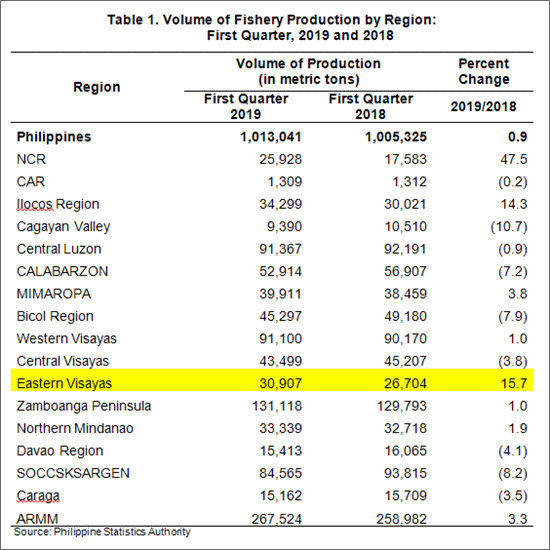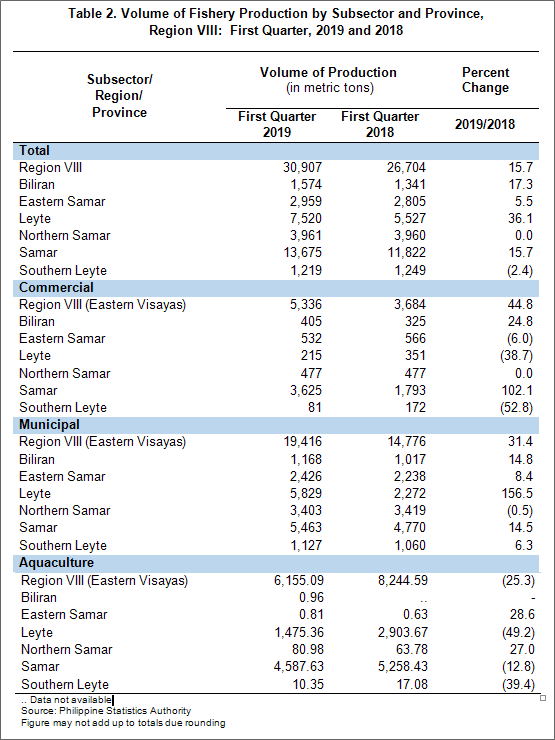P92-M revetment
protects coastal community in San Joaquin, Calbayog City
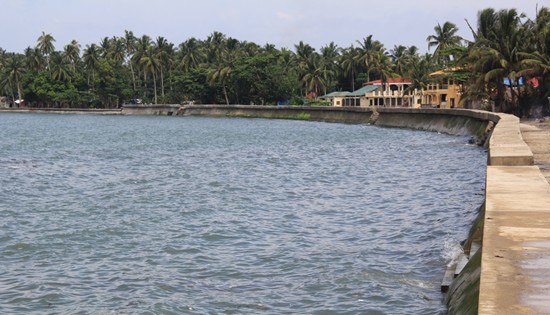
By
CHENZI MAY D. UY
August 23, 2019
CALBAYOG CITY – The
coastal community of Barangay San Joaquin in Calbayog City, Samar
are now better protected against strong waves and floods with the
completion of an 872-linear-meter revetment. The structure was
erected at a height of about three (3) meters to arrest the strong
waves that hit the shore.
The newly constructed
revetment, which amounts to P92 million, provides coastal erosion
defense and protection of lives and properties along the coast,
according to the Department of Public Works and Highways Samar First
District Engineering Office.
San Joaquin is home to
over 6,100 people or around 1,200 households, many of whom are
situated near the sea.
One of the coastal
residents, Willie Alvarez Francisco, 67, says the high tide brings
seawater inside their home and their situation becomes more
precarious whenever there’s a weather disturbance.
|
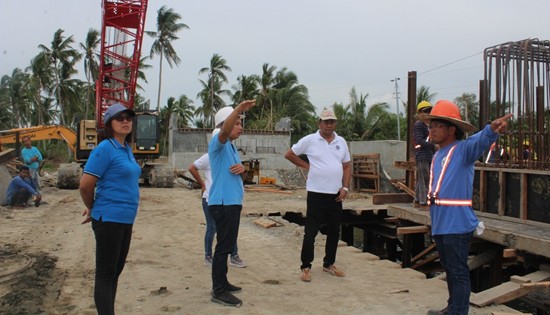
District
Engineer Gerald Pacanan, Construction Chief Norberto Boco
and Quality Assurance Section OIC-Chief Cielo Barcelo
discuss with the representative of the contractor about the
project implementation. |
P39.2 million
road networks to link Leyte villages
By
DPWH 2nd LED
August 23, 2019
BARUGO, Leyte – A
total of P39.2 million has been allocated for the construction of
Minuhang (Baluarte)-Balud and Balud-Duka road in Barugo, Leyte, the
Department of Public Works and Highways (DPWH) Leyte Second district
engineering office reported.
With the 154.8 meters
bridge with a width of 7.32 meters, residents of Minuhang, Balud,
and Duka could easily transport their agricultural and marine
products.
According to District
Engineer Gerald Pacanan, the construction of this project aims to
support the Barugo Eco Zone and improve trade, investment,
employment, education and overall progress in the said town.
“Once completed, this road
network would provide access to all kinds of vehicles, thus,
transportation of commodities will be easier and cheaper. Moreover,
this would also grant safer and shorter travels for students in
going to and from their schools,” he added.
This road network is
located along the Bagahupi-Babatngon-Sta. Cruz-Barugo-Carigara
national highway.
Moreover, the project will
also serve as an alternate route in the event that Palo-Carigara-Ormoc
road is not passable.
The access road is
targeted to be completed before the year ends.
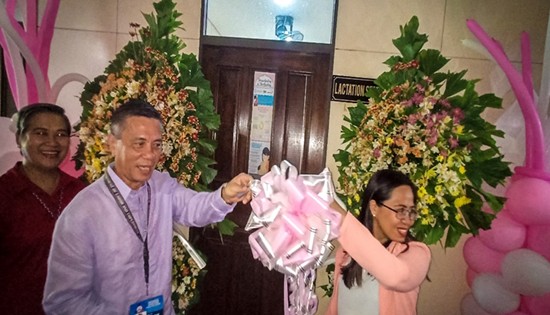
NMP
Key Officials lead the launching of the NMP Lactation
Station. |
NMP launches new
lactation station
By
National Maritime
Polytechnic
August 22, 2019
TACLOBAN CITY –
Pursuant to Republic Act No. 10028, also known as the Expanded
Breastfeeding Promotion Act of 2009, mandating the establishment of
breast feeding facility in public places and facilities, as well as
in government and private workplaces, the National Maritime
Polytechnic (NMP) launched its lactation station located at the 2nd
Floor of the NMP Administration Building, Cabalawan, Tacloban City
on 19 August 2019.
A perfect gift for NMP’s
working mothers and female clients, just in time for the observance
of the National Breastfeeding Awareness Month this August, the
launching of the NMP’s lactation station intends to highlight the
importance of breastfeeding which has proven to have a lot of
beneficial effects not only to babies but also to mothers.
The institution of the
lactation station is in support of the State’s policy to protect
working women by providing safe and healthful working conditions,
taking into account their maternal functions, and such facilities
and opportunities that will enhance their welfare and enable them to
realize their full potential in the service of the nation.
It is also part of the
localization of the Magna Carta of Women (MCW) which aims to address
the practical gender needs of working mothers. NMP lactation station
is adequately provided with the necessary equipment and facilities,
such as comfortable seat; refrigerator for storing expressed
breastmilk; lavatory for hand-washing; purified water for drinking;
and electric fan for ventilation and is open during weekdays from
8AM to 5PM.
Moreover, in order to
raise public awareness on the importance of and to further promote
breastfeeding, a Seminar-Lecture on Breastfeeding was facilitated by
the NMP Gender and Development (GAD) Committee. Resource Speakers
were Ms. Felecita R. Borata and Ms. Kristel Agote from the
Department of Health (DOH) Eastern Visayas.
Ms. Borata expressed her
appreciation on NMP’s effort of establishing a mother-baby friendly
workplace and for promoting, protecting, and supporting
breastfeeding.
The lecture highlighted
the many benefits of breastfeeding to women and children and the
proper positioning and attachment for effective breastfeeding. It
was also emphasized that one of the factors that contribute to the
success of breastfeeding is the existence of mother’s support group
(husbands, relatives, and friends).
The activity was attended
by NMP personnel and some residents and barangay officials of Brgy.
Cabalawan, Tacloban City.
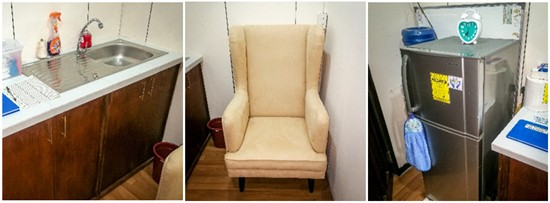
Equipment
and facilities inside the NMP Lactation Station. |
|
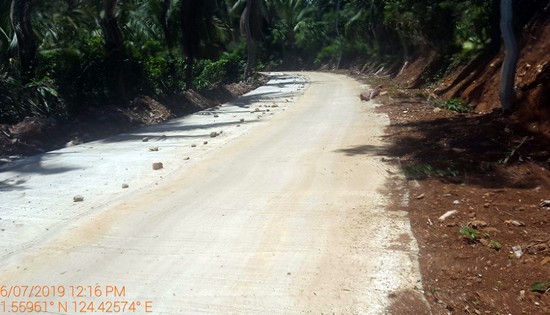
P18.29M
improvement of access road leading to trades, industries and
economic zones CarayCaray-Cabungaan-Libtong Road in Support
of the Agribusiness: Food and Resource-Based Processing in
Brgy. Libtong, Naval, Biliran is on-going with 60%
accomplishment as of June 30, 2019. The project was started
on July 31, 2019 [sic] under contract with MB Ang
Construction and Supply. Its completion date is on January
05, 2020. |
Road connectivity
for industry and trade in Biliran underway
By
DPWH-Biliran
August 21, 2019
NAVAL, Biliran –
“More road projects leading to trades, industries, and economic
zones in Biliran are underway”, David P. Adongay Jr., District
Engineer of Biliran District Engineering Office (DEO) reported.
The Department of Public
Works and Highways (DPWH) in convergence with the Department of
Trade and Industry (DTI) has identified and prioritized six road
connectivity for industry and trade in the province.
According to Adongay,
three projects under 2019 Regular Infrastructure Program are now
on-going.
The head of Biliran DEO
said that among the prioritized projects for road improvements are
the access roads in Villa Caneja connecting to Sitio Kahukaw in
support of its cassava, kamote, and ginger food and resource-based
processing (P19.29M), the road from the National Road Junction (NRJ)
in Villa Consuelo connecting to Libtong Road in support of its coco
sugar, turmeric, banana chips, cacao, and ginger-based processing
products (P17.35M) and the improvement of access road from
Caraycaray-Cabungaan-Libtong Road in support of its cassava, kamote
and curioso-based processing (P18.29M), all in Naval town.
“These projects will be
implemented under multi-year funding from 2018-2022, except for the
improvement of access road in Villa Caneja connecting to Sitio
Kahukaw which will be implemented from year 2018-2019,” Adongay
revealed.
Moreover, three projects
in lined under 2019 Local Infrastructure Projects (LIP) are soon to
be implemented. These projects are the P9.6M Road Concreting from
Brgy. Masagaosao Core Road connecting to Masagaosao Community Based
Forest Management (CBFM) Farmers Association in Kawayan town in
support of its food and resource-based processing (coconut, cacao
and coffee), the P9.6M Rehabilitation/ Improvement from Sitio Buri
to Brgy. Ungali Core in Kawayan town in support to its banana and
coconut food and resource-based and the P30M Road Concreting of P.S.
Eamiguel to Brgy. Imelda Road in Naval town in support of their
native delicacies such as puto cheese, sampilo, moron, and empanada.
Adongay said that these
projects will be monitored for fast completion in accordance with
DPWH quality and standards.
“With better roads leading
to trades and industries, more locals will be encouraged to do
business that in return will create an additional livelihood and
income,” said Adongay.
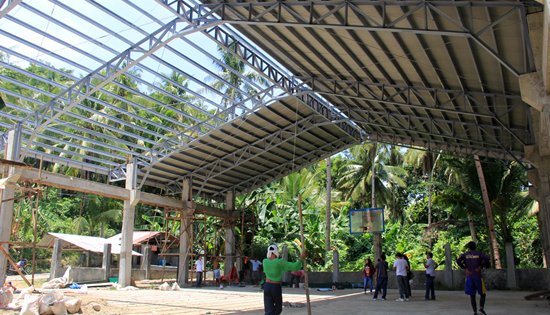
Ongoing
construction of Multi-Purpose Building in Brgy. Saljag,
Calbayog City. |
P31-M
multi-purpose buildings to rise in Calbayog
By
JASON DELOS T. ANGELES
August 21, 2019
CALBAYOG CITY –
Thirteen multi-purpose buildings are set to rise in Calbayog City,
with a combined allocation of P31 million under the 2019 DPWH
infrastructure program of DPWH Samar First District Engineering
Office.
These MPBs are located in
the following barangays: Rawis, Bagacay, Hamorawon, Cagboborac, San
Joaquin, San Rufino, San Policarpo National High School, Saljag
(Phase I), Matobato (Phase I), Caglanipao Sur (Phase II), Basud
(Phase II), Capoocan (Phase II), Jose Rońo (Phase II).
MPB projects in Calbayog
will provide a decent venue for all community-based, socio-cultural
and economic activities within the aforementioned barangays. On the
other hand, it will serve as temporary shelter to the families
affective during times of man-made and natural calamities.
As of August 2019, the
Multi-Purpose building projects in Calbayog are near completion
based on data gathered. All projects are estimated to be
accomplished within the year.
Karapatan:
Intensified police presence in campuses, an attack on academic
freedom & prelude to military take-over of schools
By
KARAPATAN
August 21, 2019
QUEZON CITY –
Rights alliance Karapatan rejects former Philippine National Police
(PNP) chief and Senator Roland “Bato” dela Rosa’s proposal to enact
a law that will allow intensified police visibility in campuses, as
well as the PNP’s calls to review the Soto-Enrile Accord which, if
invalidated, pose grave threats to academic freedom and democratic
rights.
“Bato does not want
critical students. He wants robots like leaders of the Duterte Youth
who follow orders without questions, and he proposes to do this by
terrorizing schools,” said Karapatan secretary general Cristina
Palabay, in response to Bato’s proposal to allow police elements
inside schools.
“After miserably failing
to turn public opinion in relentlessly attacking and demonizing
activists for encouraging the youth to join the struggle for human
rights and social justice, the state forces now want to infiltrate
schools in order to suppress dissent. We at Karapatan strongly
oppose Bato’s proposal to allow intensified presence and visibility
of the state forces in schools. A law of such kind will provide the
groundwork for the wholesale violation of academic freedom and the
constitutionally-granted rights to organize and free expression, and
the placement of campuses in the country under a de facto martial
law. It seems that the only thing that this government knows is to
perpetrate fear mongering and relentless militarization, rather than
addressing the legitimate grievances of the people which lie at the
root of dissent,” added Palabay.
Dela Rosa expressed his
intentions to push for the heightening of police presence in
campuses to supposedly protect minors and the youth from the
“communist indoctrination” and recruitment of “left-leaning”
organizations in schools. Furthermore, according to PNP spokesperson
Brigadier General Bernard Banac, the PNP’s call for heightened
presence in campuses is part of the counterinsurgency operations of
the National Task Force to End Local Communist Armed Conflict.
According to Palabay, by
using the very pretext of counterinsurgency, the PNP is explicitly
stating its intentions to violate international humanitarian law
which prohibits armed elements from operating in schools and using
them as bases for armed conflict while they are being used for
educational purposes – thereby exposing the state’s willingness to
endanger the lives of the youth and commit human rights violations
to just achieve its fascist ends.
“It doesn’t come as a
surprise, however, that Bato proposes a measure which violates human
rights and international humanitarian law. Let us remind him that
his hands are bloodied with countless human rights violations, with
the blood of students and young Filipinos such as Kian Loyd Delos
Santos, Myka Ulpina, Skyler Abatayo, and thousands more who have
been killed under this regime’s drug war. Bato cannot pretend to
care for the lives of the youth when he has perpetrated the
arbitrary killing of our Filipinos. He and this government have
caused irreparable damage to the lives of Filipino families,”
reminded Palabay.
The Karapatan official
expressed that “the fascist state doesn’t even distinguish unarmed
activists and armed combatants in its communist witch-hunt. By
red-tagging activists and legal mass organizations, the state is
maliciously designating unarmed activists and human rights defenders
as terrorists and parties to armed conflict, therefore legitimizing
state violence against activists. This is dangerous as we all have
seen this regime’s bloodlust and readiness to kill, violate rights,
and arbitrarily dismiss the dignity of Filipinos,” Palabay stated
further.
Along with calls to revive
the Anti-Subversion Law, the Karapatan official also warned that the
proposal to allow the police to freely enter campuses sends a
chilling effect to schools, students, faculty, and administrators
who are critical of the regime’s anti-people policies.
“Allowing the police to
freely enter and infiltrate campuses places the lives of student
activists and organizations, faculty members, and administrations at
risk of being placed under massive surveillance, intimidation, and
harassment from state forces – even if state forces have been known
to conduct such even without the approval of school administrations.
Coupled with an Anti-Subversion Law, it is the perfect recipe for a
de facto martial law situation in schools. It really is meant to
silence dissent. A student criticizing the fascist regime or a
professor teaching Marx and critical texts in a class can be tagged
as a subversive and be expelled, or worse, abducted, arbitrarily
arrested, even killed, by state forces,” Palabay said.
Karapatan instead urged
the government to uphold academic freedom and democratic rights
rather than resorting to campus repression by addressing the
concerns of activists, as well as the root causes of armed conflict.
“Activism and social
unrest thrive because the government refuses to listen to the
demands of the people; activism thrives because the government
answers the people’s legitimate demands with guns and bullets.
Duterte, Bato, and their lapdogs in the AFP and PNP should not
wonder, then, why more and more youth are joining the ranks of
activist groups. Repression begets resistance, and Duterte’s fascist
policies are only giving the people more reasons to fight back,” the
Karapatan official ended.
New wage hike for
Eastern Visayas workers takes effect
By
DOLE-8
August 20, 2019
TACLOBAN CITY – As
Wage Order No. RB VIII-21, “Prescribing New Minimum Wage Rates for
Eastern Visayas”, takes effect on August 18, 2019, the Department of
Labor and Employment Regional Office VIII urges employers to
immediately comply.
Director Yahya A. Centi,
DOLE RO VIII Director and Chairman of the Regional Tripartite Wages
and Productivity Board (RTWPB), happily announced in an interview
with media practitioner the effectivity of the new wage order.
“After all the region-wide
consultations with different sectors, I am happy to announce that
the wait is finally over. Our new wage order is now effective”, said
Centi.
Director Centi informed
that the regional wage board has done its best effort for the
welfare of the workers while still considering the employers’ side.
“As chairman of the board,
I can say that we have done what’s best for both our labor and
management sector in so far as wage-fixing is concerned. Having
considered the current socio-economic indicators in our region, we
are able to derive the new minimum wage”, Centi added.
With the effectivity of
Wage Order No. RB VIII-21, workers in the private sector in Region
VIII shall receive a basic wage increase of P20.00 per day to be
given in two tranches as follows: P10.00 per day for the first six
months from effectivity and additional P10.00 per day starting on
the seventh month from effectivity.
Effective August 18, new
minimum wage rates for Region VIII for the first six (6) months will
be as follows: P315.00 for workers under Non-Agriculture and
Retail/Service establishments employing 11 workers and above;
P285.00 for workers in Cottage/Handicraft, Agriculture and
Retail/Service establishments employing 10 workers and below.
After successfully issuing
the new wage order, Director Centi urged all private employers to
comply.
“We in the labor
department are now calling all our employers in the private sector
to adhere to the new order. This is our gift for our minimum wage
earners who significantly contribute to your respective businesses
here in Eastern Visayas, so please comply immediately”, Centi said.
The wage order was
approved on July 22, 2019 by the RTWPB VIII, composed of Director
Centi (Chairman), NEDA VIII OIC-Regional Director Meylene C. Rosales
(Vice-Chairperson), DTI VIII OIC-Regional Director Celerina T. Bato
(Vice-Chairperson), Mr. Orlando C. Uy (Employers’ Representative),
Atty. Miguel T. Tezon and Mr. Efren M. Gabriola (Workers’
Representative). It was published at Leyte Samar Daily Express last
August 3, 2019.
|

RNPC
Dr. Catalino P. Dotollo Jr. delivers an inspirational
message to the frontline workers of nutrition during a
Barangay Nutrition Scholar (BNS) Day on July 30, 2019. |
BNS Day caps 2019
Nutrition Month celebration
By
JACK C. GADAINGAN
August 19, 2019
GOVERNMENT CENTER,
Palo, Leyte – About 200 Barangay Nutrition Scholars (BNSs) from
around Eastern Visayas’ six provinces gathered here at the
Department of Education (DepEd) Leyte Division Gymnasium to mark
their being front-liners in the battle against malnutrition in
Region 8 on July 30, 2019.
The half-day activity
capped the Nutrition Month celebration of July carrying the theme:
“Kumain ng Wasto at Maging Aktibo…Push Nation ‘to!” And as the theme
directed the serious discussions of the gathering was mixed with
more fun activities – all involving physical activity.
Ullasini J. Pangan,
Nutrition Officer II of National Nutrition Council Region VIII
(NNC-8), tackled a brief discussion on the Nutrition Month Key
Messages, wherein she emphasized for everyone to have ONE hour or
more of physical activity every day, to reduce screen time (use of
gadgets, TV and computers) to TWO hours or less each day, and to eat
the THREE food groups every day for variety;
Nińo Archie S. Labordo,
NNC-8 Nutrition Officer III, the Outstanding Barangay Nutrition
Scholar Journey where he revealed that this year Region 8 has a
contender to the national level for the Outstanding BNS, as he urged
the congregation to strive to become as well; and
Dr. Catalino P. Dotollo
Jr., NNC-8 Regional Nutrition Program coordinator, the inspirational
message – during which he congratulated each one for a successful
event and for their efforts in uplifting the regional nutrition
situation.
Lydia O. Nuńez, Eastern
Visayas Association of Barangay Nutrition Scholars (EVA-BNS)
president, welcomed the BNSs and thanked them for their attendance
and continued support of the BNSs Body as well in the fight against
malnutrition in the region; Patrocenia De Cadiz, EVA-BNS treasurer
provided the closing message.
The fun games of the BNS
Day – highly entailing physical activities were divided into Solo
Game, Group Game, and 3N1 Dance Contest: the Solo Game were Sipa,
Limbo Rock, Hula-Hoop Defying Gravity, Piko, Tsato and Sangkayaw; the
Group Game were Patintero, Sack Race, Dodgeball and Tug of War; and
the 3N1 Dance Contest were Cha-cha, Boogie and Tango.

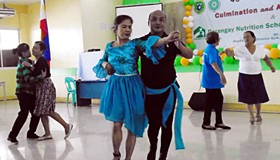
First quarter
fishery production in Eastern Visayas grows by 15.7%
By
PSA-8
August 19, 2019
TACLOBAN CITY – The
fishing industry in Eastern Visayas’ expanded as the region’s total
fish production went up to 30,907 metric tons (MT) during the first
quarter in 2019 from 26,704 MT in the same quarter in 2018, posting
an increase of 15.7 percent.
In the first quarter of
2019, Eastern Visayas ranked sixth among the regions with low
fishery production in the country with 3.0 percent contribution to
the country’s total fishery production.
Among provinces, Samar
recorded the highest volume of fish production at 13,675 MT,
comprising 44.2 percent of the total fishery production in the
region. Leyte ranked second at 7,520 MT, accounting for 24.3 percent
of the region’s total fish production. Southern Leyte, meanwhile,
had the lowest volume of production at 1,219 MT which shared only
3.9 percent.
Volume of production in
commercial fishing went up by 44.8 percent, from 3,684 MT in the
first quarter of 2018 to 5,336 MT in the same quarter of 2019. Samar
and Biliran contributed to the increase in the production in
commercial fishing with growths posted at 102.1 percent and 24.8
percent, respectively.
The rest of the provinces
registered decreases with Southern Leyte posting the biggest decline
of 52.8 percent. Northern Samar, meanwhile, retained its volume of
production in the first quarter of 2018 at 477 MT.
Similarly, the region’s
total volume of production in municipal fishing (marine and inland)
registered an increase of 31.4 percent, from 14,776 MT in the first
quarter of 2018 to 19,416 MT in the same quarter of 2019. All
provinces registered increases in municipal fishing, except Northern
Samar, which recorded a slight decline of 0.5 percent. Leyte
recorded the highest increase of 156.5 percent, from 2,272 MT in the
first quarter of 2018 to 5,829 MT during the first quarter of 2019.
Among provinces, Leyte
posted the highest contribution to the total municipal fishery
(marine and inland) production in the region with 30.0 percent share
or 5,829 MT. Samar ranked second with 5,463 MT accounting for 28.1
percent. Southern Leyte, meanwhile, registered the lowest
contribution with 5.8 percent share or 1,127 MT during the first
quarter of 2019.
Meanwhile, volume of
production in aquaculture recorded a decline of 25.3 percent, from
8,244 MT in the first quarter of 2018 to 6,155 MT in the same period
of 2019. Eastern Samar and Northern Samar exhibited growths in
production with Eastern Samar registering the highest increase of
28.6 percent. The rest of the provinces registered decreases with
Leyte recording the highest decline of 49.2 percent.
More than three fifths or
62.8 percent (19,416 MT) of the total fishery production in the
region were from municipal fishing. Aquaculture contributed 19.9
percent (6,155 MT), while commercial fishing accounted for 17.3
percent (5,336 MT).
